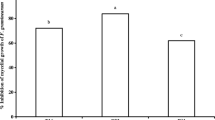Abstract
Antifungal activity of hyoscyamine (Hcy) and scopolamine (Sco) were determined by TLC-bioautography against fungi associated with H. muticus grown in Egypt, and those isolated from other plants grown in Japan. All 40 fungal strains were tolerant to Sco and sensitive to Hcy, exhibiting a growth inhibition zone around the Hcy spot on the bioautography plate. The strains were grouped into three types based on the appearance of the inhibition zone: (i) 17 strains exhibiting a clear inhibition zone, which remained clear at 8 d after incubation (type I); (ii) 22 strains exhibiting the inhibition zone with a brown circle surrounding the zone and regrowth within the inhibition zone (type II); (iii) 1 strain exhibiting the inhibition zone with no brown circle and regrowth within the inhibition zone (type III). In the type II and III strains, Hcy disappeared, and other alkaloids were found in the inhibition zones in its place. Hcy feeding experiments using Penicillium purpurogenum (type II) and Cunninghamella elegans (type III) revealed that these fungi may convert Hcy to a new alkaloid compound.
Similar content being viewed by others
Abbreviations
- 1-BuOH:
-
1-butanol
- Hcy:
-
hyoscyamine
- PDB:
-
potato dextrose broth
- Sco:
-
scopolamine
- TA(s):
-
tropane alkaloid(s)
References
Abad M.J., Ansuategui M., Bermejo P.: Active antifungal substances from natural sources. Arkivok 7, 116–145 (2007).
Alves M.N., Sartoratto A., Trigo J.R.: Scopolamine in Brugmansia suaveolens (Solanaceae): defense, allocation, cost, and induced response. J.Chem.Ecol. 33, 297–309 (2007).
Dabur R., Singh H., Chhillar A.K., Ali M., Sharma G.L.: Antifungal potential of Indian medicinal plants. Fitotherapia 75, 389–391 (2004).
El-Zayat S.A., Nassar M.S., El-Hissy F.T., Abdel-Motaal F.F., Ito S.: Mycoflora associated with Hyoscyamus muticus growing under an extremely arid desert environment (Aswan region, Egypt). J.Basic Microbiol. 48, 82–92 (2008).
Evans W.C.: Tropane alkaloids of the Solanaceae, pp. 241–254 in J.G. Hawkes, R.N. Lester, A.D. Skelding (Eds): The Biology and Taxonomy of the Solanaceae. Academic Press, London 1979.
Hol W.H.G., van Veen J.A.: Pyrrolizidine alkaloids from Senecio jacobaea affected fungal growth. J.Chem.Ecol. 28, 1763–1772 (2002).
Hsiao T.H., Frankel G.: The role of secondary plant substances in the food specificity of the Colorado potato beetle. Ann.Entomol. Soc.Am. 61, 485–503 (1968).
Ishimoto H., Fukushi Y., Yoshida T., Tahara S.: Rhizopus and Fusarium are selected as dominant fungal genera in the rhizospheres of Brassicaceae. J.Chem.Ecol. 26, 2387–2399 (2000).
Ito S., Eto T., Tanaka S., Yamauchi N., Takahara H., Ikeda T.: Tomatidine and lycotetraose, hydrolysis products of α-tomatine by Fusarium oxysporum tomatinase, suppress induced defense responses in tomato cells. FEBS Lett. 571, 31–34 (2004).
Krug E., Proksch P.: Influence of dietary alkaloids on survival and growth of Spodoptera littoralis. Biochem.Syst.Ecol. 21, 749–756 (1993).
Nuhu H., Ghani A.: Alkaloid content of the leaves of three Nigerian Datura species. Nigerian J.Nat.Prod.Med. 6, 15–18 (2002).
Osbourn A.E.: Molecules of interest: saponins in cereals. Phytochemistry 62, 1–4 (2003).
Rathbone D.A., Bruce N.C.: Microbial transformation of alkaloids. Curr.Opin.Microbiol. 5, 274–281 (2002).
Romeike A.: Die Rolle von Sproß und Wurzel bei der Unwandlung des Hyoscyamins in verschiedenen Datura-Arten. Planta Med. 8, 491–496 (1960).
Romeike A.: Tropane alkaloids-occurrence and systematic importance in angiosperms. Bot.Notiser. 131, 85–96 (1978).
Shafique S., Shafique S.: Antifungal activity of n-hexane extracts of Datura metel against Ascochyta rabiel. Mycopathology 6, 31–35 (2008).
Sharma R.G.L.: Studies on antimycotic properties of Datura metel. J.Ethnopharm. 80, 193–197 (2002).
Sreevidya N., Mehrotra S.J.: Spectrophotometric method for estimation of alkaloids perceptible with Dragendorff’s reagent in plant materials. J.AOAC Internat. 86, 1124–1127 (2003).
The World Conservation Union: A Guide to Medicinal Plants in North Africa. IUCN Centre for Mediterranean Cooperation, Malaga 2005.
Tolba M.K. El-Hissy F.T.: A preliminary investigation of the antifungal activities of some flowering plants in upper Egypt. Egypt. J.Bot. 15, 111–120 (1972).
Werner C., Petrini O., Hesse M.: Degradation of polyamine alkaloids aphelandrine by endophytic fungi isolated from Aphelandra tetragona. FEMS Microbiol.Lett. 155, 147–153 (1997).
Wink M.: Allelochemical properties or raison d’etre of alkaloids, pp. 1–118 in G.A. Cordell (Ed.): The Alkaloids, Vol. 43. Academic Press, San Diego 1993.
Author information
Authors and Affiliations
Corresponding author
Rights and permissions
About this article
Cite this article
Abdel-Motaal, F.F., Nassar, M.S.M., El-Zayat, S.A. et al. responses of fungi to tropane alkaloids produced by a medicinal plant Hyoscyamus muticus (Egyptian Henbane). Folia Microbiol 54, 207–212 (2009). https://doi.org/10.1007/s12223-009-0033-6
Received:
Revised:
Published:
Issue Date:
DOI: https://doi.org/10.1007/s12223-009-0033-6




